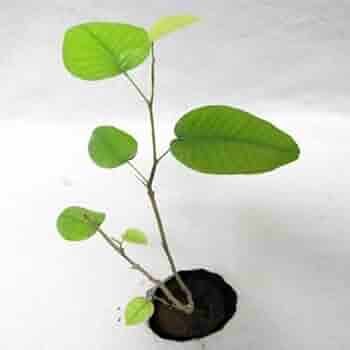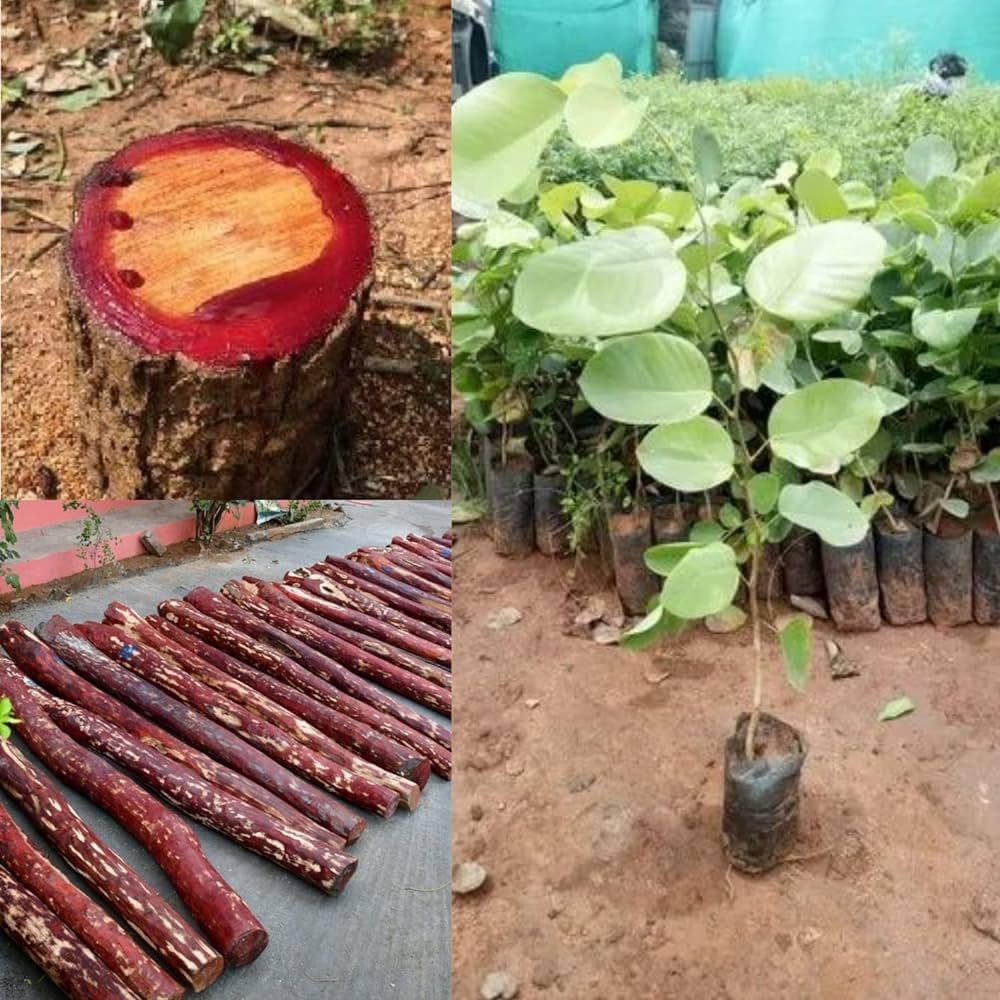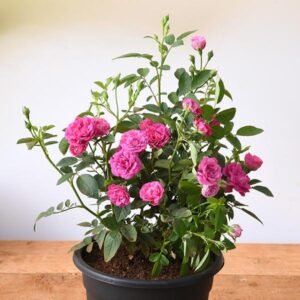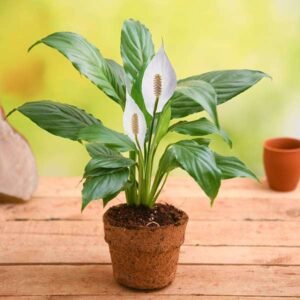Description
Red Chandan Plant (Pterocarpus santalinus): A Complete Overview
The Red Chandan plant, scientifically known as Pterocarpus santalinus, is a highly valuable and culturally significant tree native to the southern parts of India, particularly the state of Andhra Pradesh. Also known as Red Sandalwood, this slow-growing tree is prized for its deep red-colored heartwood, which has been used for centuries for medicinal, cosmetic, spiritual, and decorative purposes.
Botanical Classification
- Common Name: Red Chandan, Red Sandalwood
- Scientific Name: Pterocarpus santalinus
- Family: Fabaceae (Legume family)
- Genus: Pterocarpus
- Species: santalinus
- Native Region: Eastern Ghats, South India, especially Andhra Pradesh
Physical Characteristics
The Red Chandan tree is a small to medium-sized deciduous tree, typically growing up to 8–12 meters in height. It has a crooked trunk and an irregular branching pattern. The bark is dark greyish-brown and appears scaly with longitudinal fissures.
- Leaves: Pinnate and alternate with 5–7 leaflets. The leaves are green, leathery, and oval-shaped.
- Flowers: Small, yellowish flowers bloom during the spring and summer seasons. They are generally inconspicuous and occur in clusters.
- Fruit: The tree produces flat, disc-shaped pods with a single seed inside.
- Wood: The heartwood is what makes Red Chandan so valuable. It is dark reddish or purplish in color, hard, and highly durable.
Growth and Cultivation
Red Chandan trees thrive in dry, deciduous forests and hilly terrains. They prefer well-drained, red sandy loam soils and require a warm tropical climate with moderate rainfall (about 800–1000 mm annually).
- Climate: Semi-arid to humid tropical climates
- Soil: Red sandy loam or rocky soil with good drainage
- Propagation: Mostly propagated by seeds, though vegetative propagation through stem cuttings is also possible.
- Growth Rate: Slow-growing; it may take 15–20 years or more to mature fully for commercial use.
Economic Importance
Red Chandan is one of the most expensive woods in the world due to its color, rarity, and wide range of uses. The tree is classified as endangered due to overharvesting, and its trade is strictly regulated under the CITES (Convention on International Trade in Endangered Species) agreement.
Major Uses:
- Woodworking and Furniture:
- Used for carving idols, sculptures, and high-end furniture
- Valued for its rich color and grain pattern
- Often used in musical instruments and luxury decorative items
- Medicinal Uses:
- Used in Ayurvedic and traditional Chinese medicine
- The wood powder is believed to treat skin conditions, fever, inflammation, and blood purification
- Decoctions made from the heartwood are used to treat digestive issues and respiratory problems
- Cosmetics and Skincare:
- Used in face packs, soaps, and skin creams
- Known for its anti-inflammatory, antibacterial, and cooling properties
- Dye and Coloring Agent:
- The red pigment (santalin) is extracted and used as a natural dye in textiles and cosmetics
- Spiritual and Religious:
- Used in temples and spiritual rituals
- Powdered wood is used to make tilak (forehead mark) and incense sticks
Ecological Benefits
Besides its commercial value, Red Chandan also contributes to ecological health:
- Soil Enrichment: As a leguminous plant, it helps fix nitrogen in the soil, improving fertility
- Erosion Control: Deep root systems help prevent soil erosion in hilly regions
- Biodiversity Support: Provides habitat for birds and insects
Conservation Status
Due to overexploitation, smuggling, and illegal logging, Pterocarpus santalinus is listed as Endangered on the IUCN Red List. Its harvesting and export are tightly controlled by the Indian government.
- Trade Regulation: Under Appendix II of CITES
- Protection in India: Governed by the Indian Forest Act and Wildlife Protection Act
- Cultivation Promotion: Encouraged under agroforestry programs with licensing and monitoring
Challenges in Cultivation
- Slow Growth: Takes many years to mature, making it a long-term investment
- Susceptibility to Pests: Especially during the seedling stage
- Strict Legal Regulations: Difficult to obtain permits for planting, harvesting, and selling
- High Demand Leading to Illegal Trade: Risk of theft and smuggling from private plantations
Red Chandan vs. White Sandalwood
While both are called “sandalwood,” Red Chandan (Pterocarpus santalinus) and White Sandalwood (Santalum album) are botanically unrelated and serve different purposes:
| Feature | Red Chandan (P. santalinus) | White Sandalwood (S. album) |
|---|---|---|
| Color | Deep red to purplish | Pale yellow or cream |
| Aroma | Mild to no fragrance | Highly fragrant |
| Main Use | Woodwork, dye, medicine | Essential oil, perfume |
| Growth Region | Eastern Ghats, India | Karnataka, Tamil Nadu |
Market and Economic Potential
Red Chandan has immense economic potential, particularly in international markets like China, Japan, and Southeast Asia, where it is valued for medicine, carving, and cultural uses. Prices for heartwood can range from ₹5,000 to over ₹20,000 per kilogram, depending on quality and age.
Due to its profitability, many farmers are now investing in legal Red Chandan plantations, often under the guidance of forestry departments and agricultural universities.
Future Prospects and Sustainable Cultivation
Given its value and ecological importance, Red Chandan offers a viable avenue for long-term sustainable agroforestry. To ensure the survival of the species while benefiting economically, certain practices are recommended:
- Intercropping: Can be grown alongside crops like turmeric or ginger in early years
- Organic Practices: Avoid chemical inputs to preserve soil and wood quality
- Fencing and Surveillance: Protect against theft and grazing
- Documentation and Licensing: Ensure all cultivation is legally documented and monitored
Government schemes and subsidies are also available in some Indian states to promote its plantation under agroforestry and forest rejuvenation missions.
Conclusion
The Red Chandan plant is more than just a tree—it is a symbol of tradition, wealth, and ecological significance. Its rich red wood has earned it global fame, but this has also led to its endangerment. As awareness grows, so does the need for sustainable cultivation and strict regulation to preserve this precious species for future generations. By combining traditional knowledge with modern conservation practices, Red Chandan can continue to thrive as a legacy of India’s botanical heritage.






 Onex Pebbles (Purple, Medium) - 1 kg
Onex Pebbles (Purple, Medium) - 1 kg  Chips Pebbles (Brown, Small, Polished) - 1 kg
Chips Pebbles (Brown, Small, Polished) - 1 kg  Pack of 3 Good Luck Jade Plants in Ceramic Pots
Pack of 3 Good Luck Jade Plants in Ceramic Pots  Marble Chips Pebbles (White, Small, Polished) - 1 kg
Marble Chips Pebbles (White, Small, Polished) - 1 kg  Aquarium Pebbles (Red, Small) - 1 kg
Aquarium Pebbles (Red, Small) - 1 kg  Miniature Rose, Button Rose (Any Color) - Plant
Miniature Rose, Button Rose (Any Color) - Plant  Damascus Rose, Scented Rose (Any Color) - Plant
Damascus Rose, Scented Rose (Any Color) - Plant  Eco friendly Peace Lily - Gift Plant
Eco friendly Peace Lily - Gift Plant  Onex Pebbles (Blue, Medium) - 1 kg
Onex Pebbles (Blue, Medium) - 1 kg  LEMON GRASS-PLANT
LEMON GRASS-PLANT 

Reviews
There are no reviews yet.